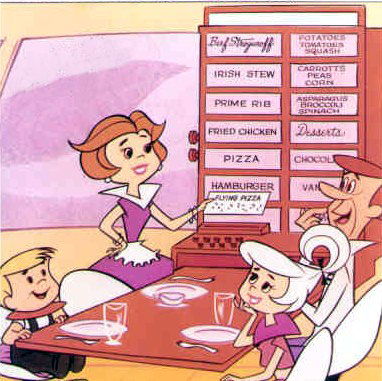 Netmix: Will we ever get to the dinners-on-demand future of The Jetsons? Sometimes the internet’s twin obsessions of cutting-edge technological innovation and science fiction offer us interesting and useful hints of the future. And sometimes … they don’t. Case in point, the FoodTubes project. The brainchild of “a consortium of academics, project planners, and engineers,” FoodTubes wants to move our fossil-fuel based transport system underground and, well, into tubes. Here’s a YouTube slideshow of the project. Writes tech blog ArsTechnica:
Netmix: Will we ever get to the dinners-on-demand future of The Jetsons? Sometimes the internet’s twin obsessions of cutting-edge technological innovation and science fiction offer us interesting and useful hints of the future. And sometimes … they don’t. Case in point, the FoodTubes project. The brainchild of “a consortium of academics, project planners, and engineers,” FoodTubes wants to move our fossil-fuel based transport system underground and, well, into tubes. Here’s a YouTube slideshow of the project. Writes tech blog ArsTechnica:
Imagine a 1,500 kilometer underground FoodTubes ring circling the UK. The packet-switched-style network would connect all major food producers and retailers via 3,000 kilos of smart grid controlled air pressure pipe. The FoodTubes capsules, spaced one meter apart, will race about in gangs of 300 or so at 100kph. As many as 900,000 will be in circulation at any given moment, either zipping around beneath London and Liverpool or being loaded and unloaded at freight dockets.
Look, I love futuristic scenarios too, but I think the chances of this coming to pass are about as great as the chances that the House and Senate Agriculture Committees will spontaneously decide to eliminate commodity subsides and spend the savings on organic agriculture.
Don’t get me wrong — I’m a fan! — but pneumatic tubes had their heyday back in the early 20th century. Remember New York City’s fantastic and amazing pneumatic tube postal system that operated from 1897-1953?:
Put into operation in New York in 1897 by the American Pneumatic Service Company, the 27-mile system connected 22 post offices in Manhattan, and the General Post office in Brooklyn. The pipes were between 4 to 12 feet underground, and in some places the tubes ran along the subway tunnels of the 4, 5, and 6 lines. At the height of its operation it carried some 95,000 letters a day, or one-third of all the mail being routed throughout New York City.
So, on the one hand, networks of pneumatic tubes running willy-nilly beneath modern cities — been there, done that. And yet, to reform both food distribution and transportation, I think we need more innovation, hard work and, yes, even sacrifice — and a lot less Jules Verne. But perhaps when oil is at $300 a barrel and food is zipping around in tubes underneath London, I will be revealed to be the Luddite skeptic that I surely am.


